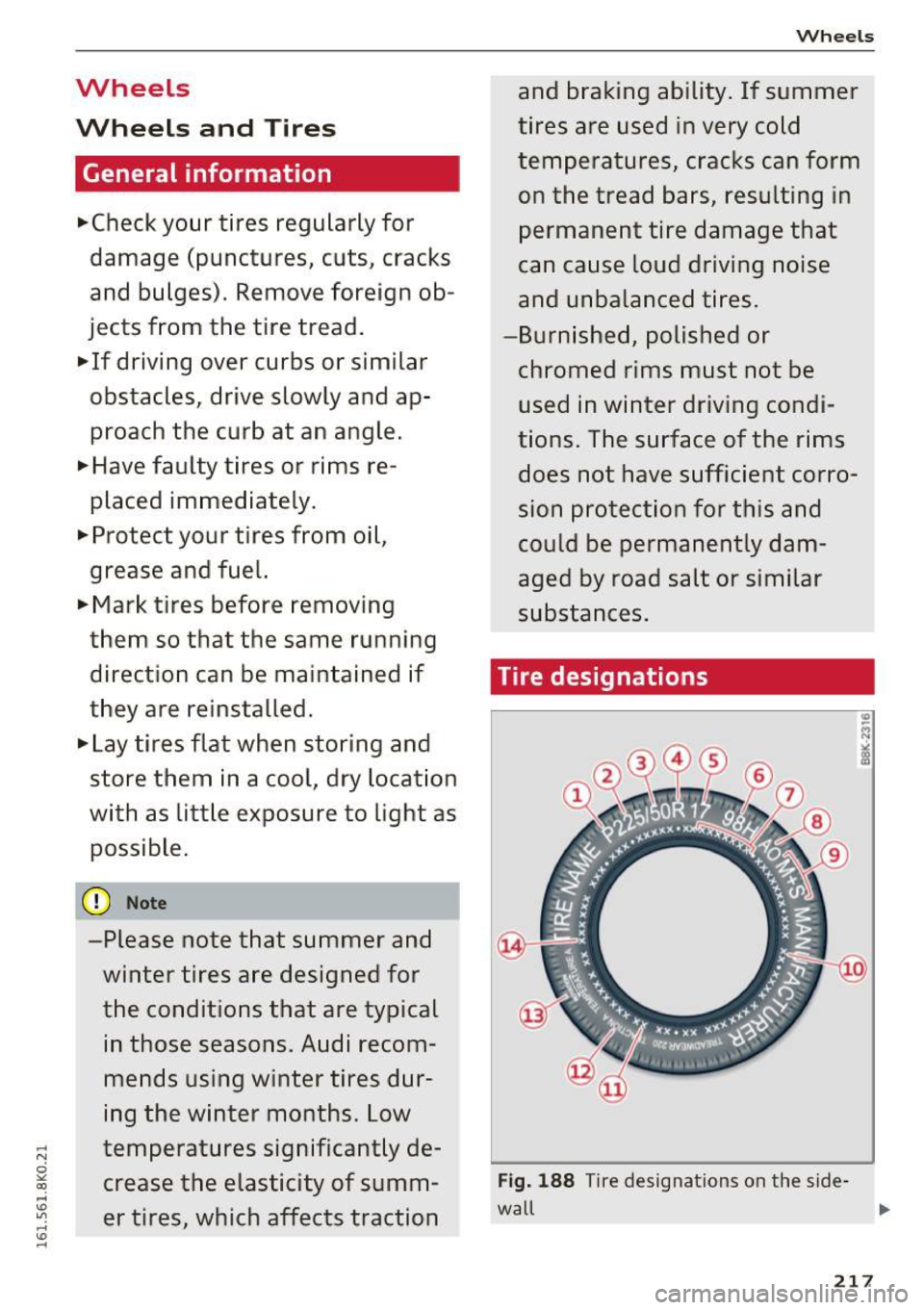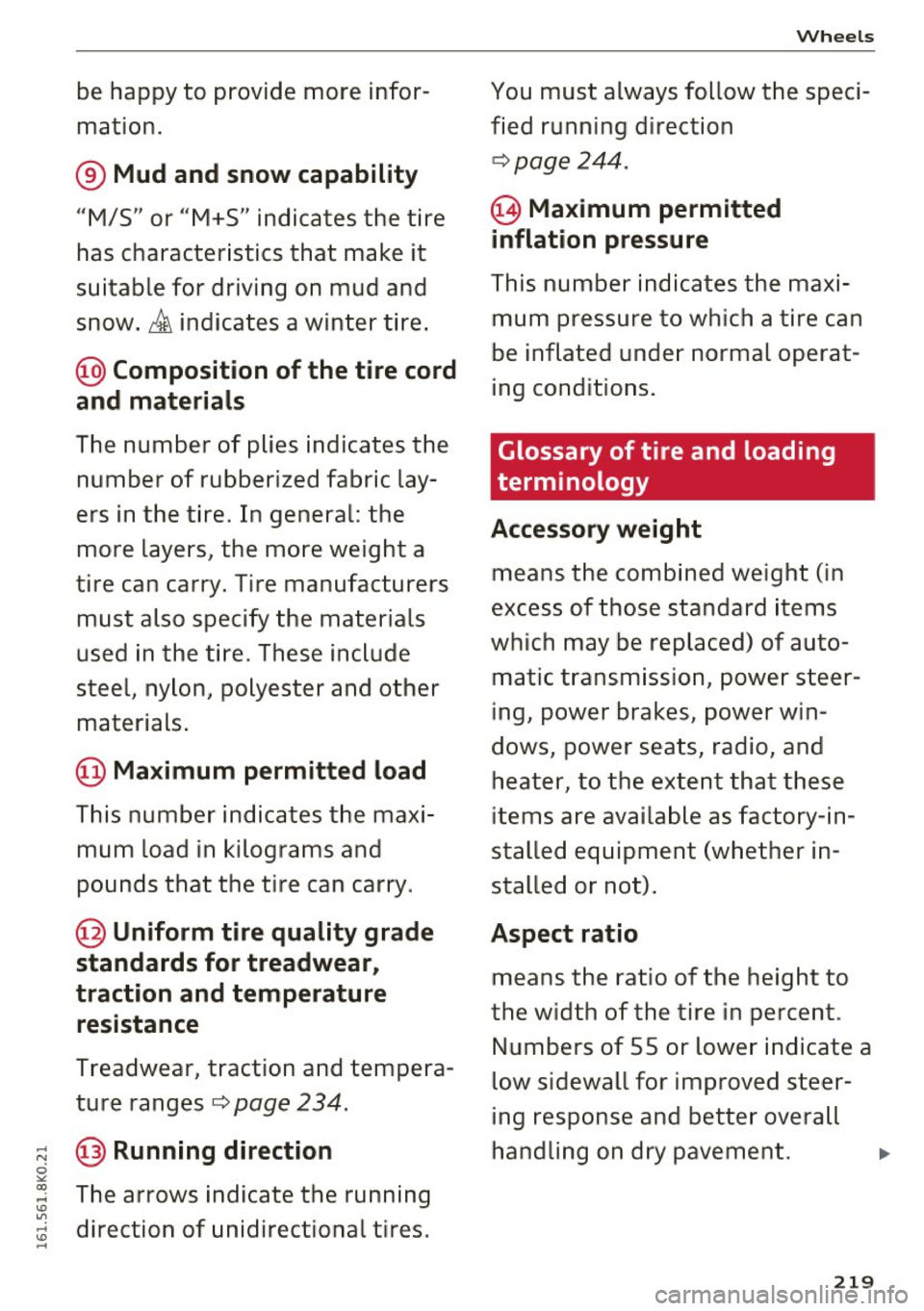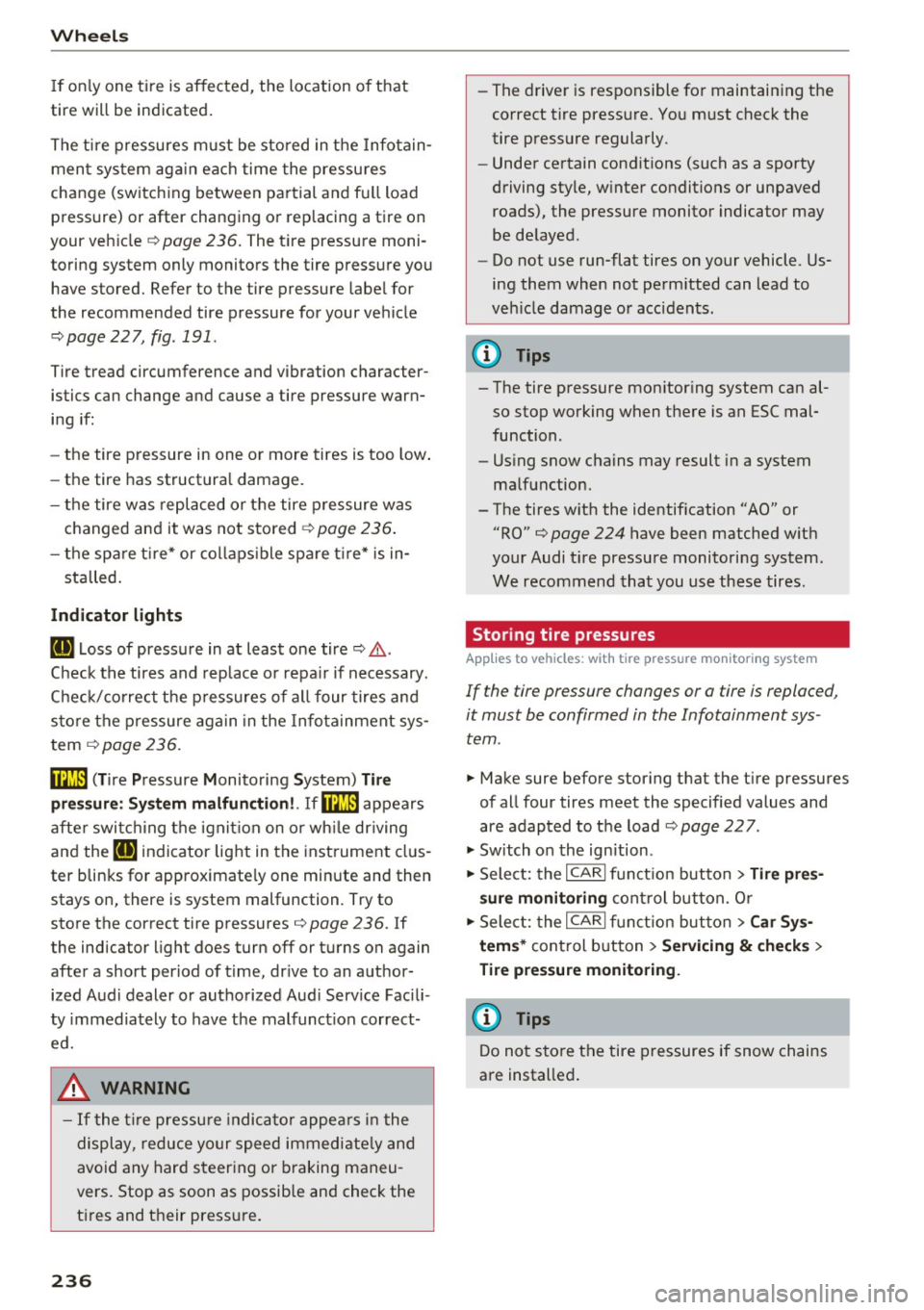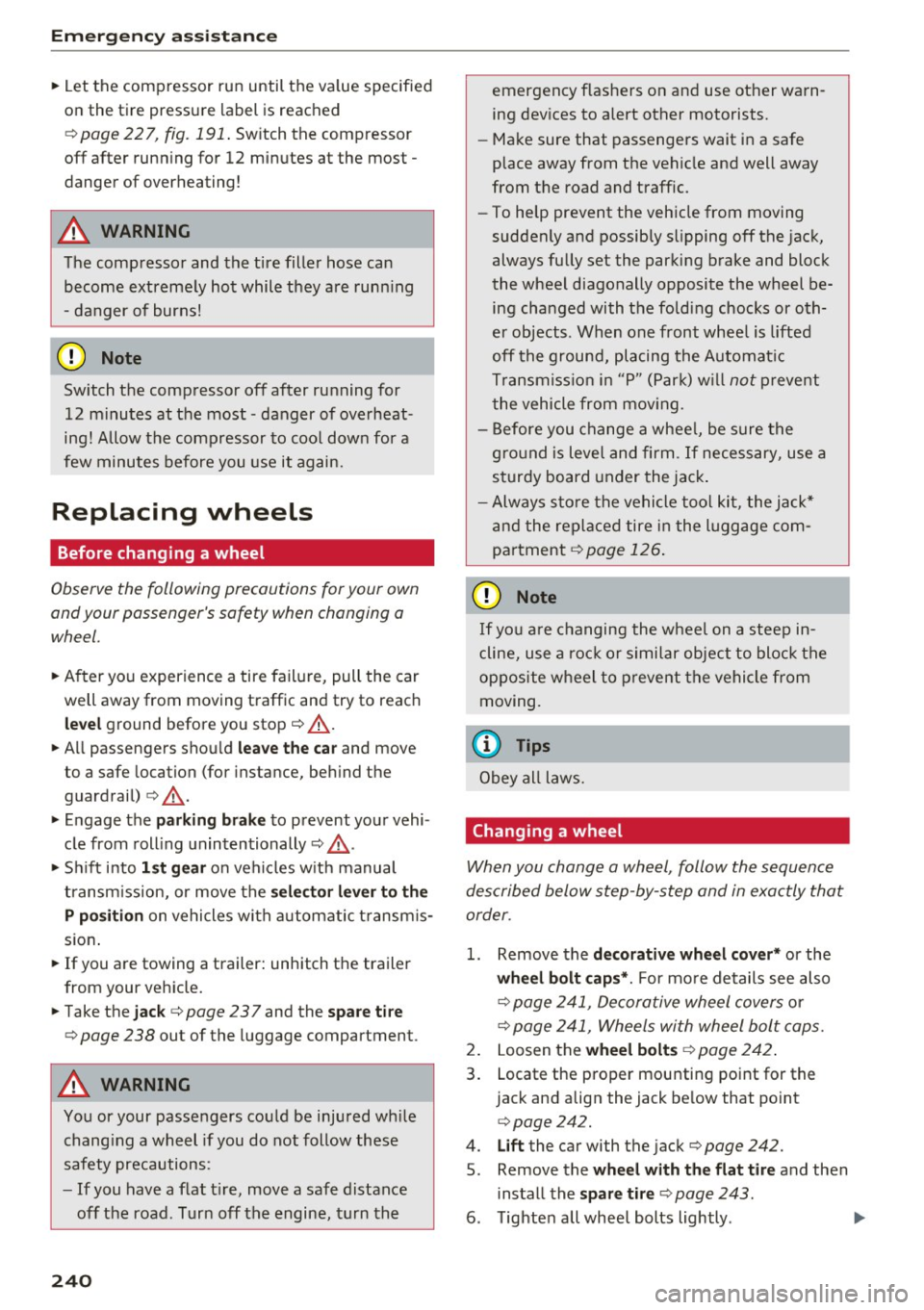run flat AUDI A4 2016 Owners Manual
[x] Cancel search | Manufacturer: AUDI, Model Year: 2016, Model line: A4, Model: AUDI A4 2016Pages: 278, PDF Size: 70.26 MB
Page 219 of 278

Wheels
Wheels and Tires
General information
.,.Check your tires regularly for
damage (punctures, cuts, cracks
and bulges). Remove foreign ob
jects from the tire tread.
.,. If driving over curbs or similar
obstacles, drive slowly and ap
proach the curb at an angle.
.,.Have faulty tires or rims re
placed immediately.
"'Protect your tires from oil,
grease and fuel.
.,.M ark tires before removing
them so that the same running
direction can be maintained if
they are reinstalled.
"'Lay tires flat when storing and
store them in a cool, dry location
with as little exposure to light as
possible.
(D Note
-Please note that summer and
winter tires are designed for
the conditions that are typical in those seasons. Audi recom
mends using winter tires dur
ing the winter months. Low
temperatures significantly de crease the elasticity of summ
er tires, which affects traction
Wheels
and braking ability. If summer
tires are used in very cold
temperatures, cracks can form
on the tread bars, resulting in
permanent tire damage that
can cause loud driving noise
and unbalanced tires.
-Burnished, polished or
chromed rims must not be
used in winter driving condi
tions. The surface of the rims
does not have sufficient corro
sion protection for this and
could be permanently dam aged by road salt or similar
substances.
Tire designations
Fig. 188 T ir e designations on the side -
wall Ill>
217
Page 221 of 278

be happy to provide more infor
mation.
® Mud and snow capability
"M/5 " or "M+S" indicates the tire
has character istics that make it
suitable for driving on mud and
snow .
& indicates a winter tire .
@Composition of the tire cord
and materials
The number of plies indicates the
number of rubberized fabric lay
ers in the tire. In general: the
more layers , the more weight a
tire can carry . Tire manufacturers
must also specify the materials
used in the tire. These inc lude
steel, nylon, polyester and other
materials.
@ Maximum permitted load
This number indicates the max i
mum load in kilograms and
pounds that the tire can carry.
@ Uniform tire quality grade
standards for treadwear,
traction and temperature resistance
Treadwear, traction and tempera
ture ranges
c::> page 234 .
;;: @ Running direction
\:i ~ ...
'° V, ....
'° ....
The arrows indicate the running
direction of unidirectional tires .
Wheels
You must always follow the speci
fied runn ing d irect ion
c::> page 244 .
@ Maximum permitted
inflation pressure
This number ind icates the maxi
mum pressure to which a tire can
be inflated unde r normal operat
ing condit ions.
Glossary of tire and loading
terminology
Accessory weight
means the comb ined weigh t (in
excess of those standard items
which may be replaced) of auto
matic transm ission, power steer
ing , power brakes, power win
dows, power seats, radio, and
heater, to the extent that these
items are available as facto ry-in
stalled equipment (whether in
stalled or not) .
Aspect ratio
means the ratio of the heigh t to
the width of the tire in percent .
Numbers of 55 or lowe r indicate a
low sidewa ll for improved steer
ing response and better overall
handling on dry pavement. .,.
219
Page 238 of 278

Wheels
If on ly one t ire is affected , the location o f that
tire will be indicated .
The tire pressures must be stored in t he Info tain
men t sys tem ag ain each time the pressu res
change (switch ing between pa rtial and f ull load
pressure) or after changing or rep lacing a tire on
your vehicle ¢
pag e 236. The t ire pressu re moni
toring system only monitors the tire pressure you have stored. Refer to the tire pressure labe l for
the recommended tire pressure for your ve hicle
¢ page 227, fig.191 .
Tire tread circumference and vibration character
istics can change and cause a tire pressure war n
i n g if:
- the tire p ressure in one o r more tires is too low .
- the tire has struct ural damage.
- the tire was repl aced o r the tire p ressure was
changed and i t was not stored
¢ page 236 .
-the sp are t ire* or co llapsible spa re t ire* i s in-
st alled.
Indicator lights
[I] Loss of press ure in at leas t one tire 9 .6, .
Check the tires and rep lace o r repa ir if necessary .
Chec k/correc t th e p ressures o f all four tires and
s to re the pressure aga in in the In fota inment sys
tem
¢ page 236 .
@m (Tir e Pr essure Monito ring System) Tire
pressure : Sy stem malfunction !. If @m
appears
a fte r swi tc hi ng t he igni tion on or wh ile dr iving
a nd the
[I] indicator light in the instrument cl us
ter blinks for approximate ly one minute and then
stays on, there is system malfunction. Try to
sto re the correct tire pressures¢
page 236. If
the indicator light does turn off or tu rns on again
afte r a short period of t ime, dr ive to an a uth or
ized Aud i dealer o r authorized Aud i Serv ice Fac ili
ty immedia tely to have the malfunct ion correct
ed.
_& WARNING
- If the tire pre ssu re indic ator appe ars in the
display, reduce your speed immedia te ly and
avoid any har d steer ing or braking maneu
vers. Stop as soon as possib le and check the
t ir es and t heir pressu re.
236
'
- The drive r is responsible fo r maintain ing the
correct tire pressu re . You m ust check the
tire pressure regularly .
- Unde r ce rtain con ditions (such as a spo rty
driving style, w inter condit ions or unpaved
roads), the pressure monitor indicato r may
be de layed.
- Do not use run-flat tires on your vehicle . U s
ing them when no t perm itted can lead to
ve hicle damage o r acciden ts.
(D Tips
- The tire p ressure mon itor ing system can al
so stop wo rking when there is an ESC mal
function .
- Us ing snow chains may result i n a system
ma lfunction.
- The tires w ith the identif ication "AO" or
"RO"¢
page 224 have been matched w it h
you r Audi t ire pressu re monitoring system.
W e recommend tha t you use these tires.
Storing tire pressures
App lies to vehicles: with tire pressure mo nitori ng syste m
If the tire pressure changes or a tire is replaced,
it must be confirmed in the Infotainment sys tem .
.,. Make sure before stor ing t hat the t ire pressures
of all four tires meet the specified values and
are adapted to t he load
¢ page 22 7 .
.,. Switch o n the ign ition .
.,. Sele ct: the
I CARI fu nct io n but ton > Tir e pres
s ure monitoring
con trol but ton. O r
.,. Sele ct: the
I CAR I funct ion but ton > Car Sys
tems*
cont rol b utton > Servicing & check s >
Tire pressure monito ring .
(D Tips
Do not s tore the tire pressures if snow chains
a re installed .
Page 242 of 278

Emergency assistance
"'Let the compressor run until the va lue specified
on the tire pressure label is reach ed
¢ page 227, fig. 191 . Switch the compressor
off after running for 12 minutes at the mos t -
danger of overheating!
A WARNING
The compressor and the tire filler hose can become extremely hot while they are running
- danger of burns!
CD Note
Switch the compressor off after running for
12 minutes at the most -danger of overheat
ing! Allow the compressor to cool down for a
few minutes before you use it again.
Replacing wheels
Before changing a wheel
Observe the following precaut ions for your own
and your passenger's safety when changing a
wheel.
"' After you experience a tire failure, pull the car
well away from moving traffic and try to reach
level ground before you stop ¢.&_ .
"' All passengers shou ld
leave the car and move
to a safe location (for instance, behind the
guardrail) ¢.&_ .
"' Engage the
parking brake to prevent your vehi
cle from rolling unintentionally ¢&_ .
"' Sh ift into
1st gear on vehicles w ith manual
transmission, or move the
selector lever to the
P position
on vehicles with automatic transmis
sion .
"' If you are towing a trailer: unhitch the trailer
from your vehicle.
"' Take the
jack¢ page 237 and the spare tire
¢ page 238 out of the luggage compartment .
A WARNING
You or your passengers could be injured wh ile
chang ing a wheel if you do not follow these
safety precautions :
- If you have a flat tire, move a safe distance
off the road . Turn off the engine, turn the
240
emergency flashers on and use other warn
ing devices to alert other motorists.
- Make sure that passengers wait in a safe
place away from the vehicle and well away
from the road and traffic.
- To help prevent the vehicle from moving
suddenly and possibly slipping off the jack,
always fully set the parking brake and block
the wheel diagonally opposite the wheel be ing changed with the folding chocks or oth
er objects . When one front whee l is lifted
off the ground, placing the Automat ic
T ransmission in "P" (Par k) w ill
not prevent
the vehicle from moving.
- Before you change a wheel, be sure the
ground is level and firm . If necessary, use a
sturdy board under the jack.
- Always store the vehicle tool kit, the jack*
and the replaced tire in the luggage com
partment
¢ page 126.
CD Note
If you a re changing the wheel on a steep in
cline, use a rock or similar object to block the
opposite wheel to prevent the vehicle from
moving.
(D Tips
Obey all laws.
Changing a wheel
When you change a wheel, follow the sequence
described below step-by-step and in exactly that
order .
1. Remove the decorative wheel cover* or the
wheel bolt caps* . For more details see also
¢ page 241, Decorative wheel covers or
¢ page 241, Wheels with wheel bolt cops.
2. Loosen the wheel bolts ¢page 242.
3. Locate the proper mounting point for the
jack and align the jack below that point
¢ page 242.
4. Lift the car with the jack¢ page 242.
5. Remove the wheel with the flat tire and then
install the
spare tire ¢page 243.
6. Tighten all whee l bolts lightly .